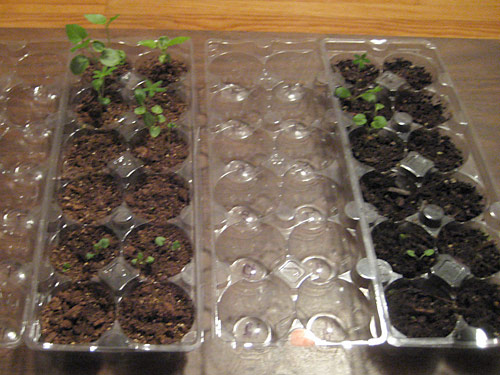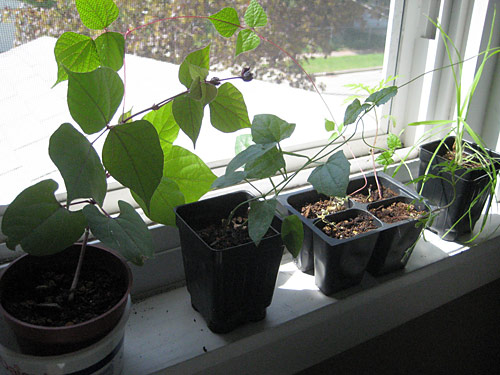Back in March, the gardening itch overtook me and I decided to take another shot at starting seeds early indoors for spring transplanting outdoors. Last season’s attempt at starting seeds went okay until I moved the plants into the Lot. They all promptly died. This was my introduction to “hardening off.”
First Things First
At the beginning of this experiment, I wanted to see what the difference results were between potting soil and seed starting mix. Throughout their growth, both sets of seedlings had the same light, water, and temperature. The plants had an easier time with the seed starting mix. Here is a shot from April 11th when I transplanted some of the seedlings into larger pots. The seed starting mix is on the left and the potting soil is on the right.

Weaklings!
Hardening off is the process by which a gardener gradually transitions an early-start seedling from the cozy indoors to the wild outdoors. When seeds are started indoors, the environment is controlled in as many ways as possible. Water, light, temperature, and wind (the absence off) is regulated. The plant itself is fragile and not yet as strong as it will be outside in the garden. Here are some of the same seedlings as above ready to start the adventure.

It’s All About Gradual Acclimation
After surfing around The Internets, I found a handful of university sites that gave tips on how to harden off plants. Here is what I found to be the general consensus:
- Set seedlings outside in a somewhat shaded, protected (from the wind) area for an hour or two. Bring back in afterward.
- Each day, over a period of about 7-10 days, increase exposure to sun and outside elements by an hour.
- Do not fertilize during this process.
- Sources vary on whether or not seedlings’ watering routine should be cut back as well.
- Once in the garden, the seedlings can receive a weak fertilizer solution to help ease transplant shock and get them growing again.
Sounds easy enough.
But Remember…
- Watch out for low evening temperatures. If it is going to dip lower than the plant likes (it’s hardiness), simply cover it for the night.
- When transplanting, pick an overcast day so the seedlings are not dealing with the new digs AND a bright sun at the same time.
- As when planting any new member in the garden, let watering settle the soil around the plant instead of pressing hard and compacting the soil around the seedling’s roots.
These are all ideal conditions for the hardening off process. The plants will not instantly drop dead if the guidelines are not strictly followed. So, beginning this week, our seedlings will begin their journey to great outdoors that is the Lot.
